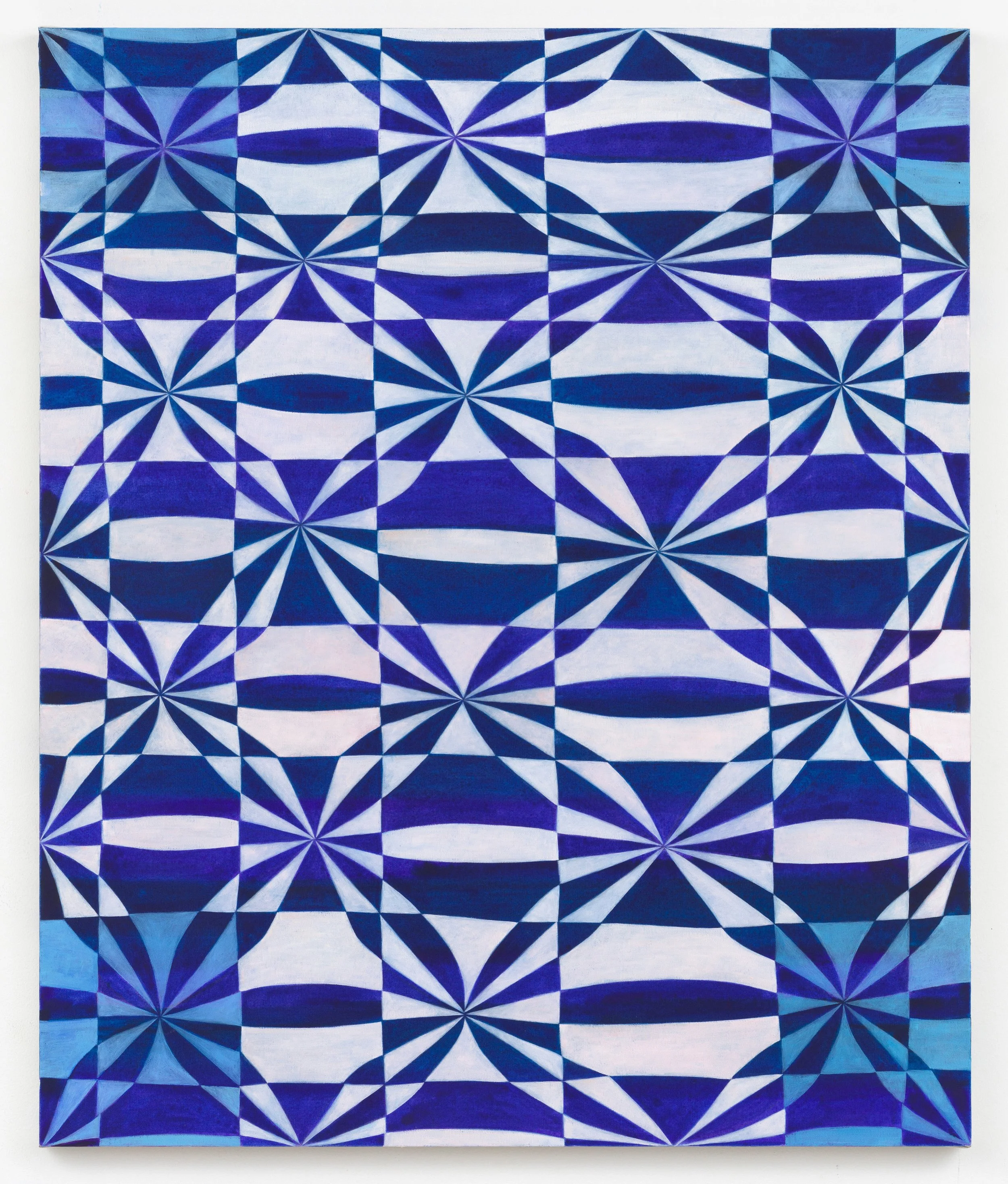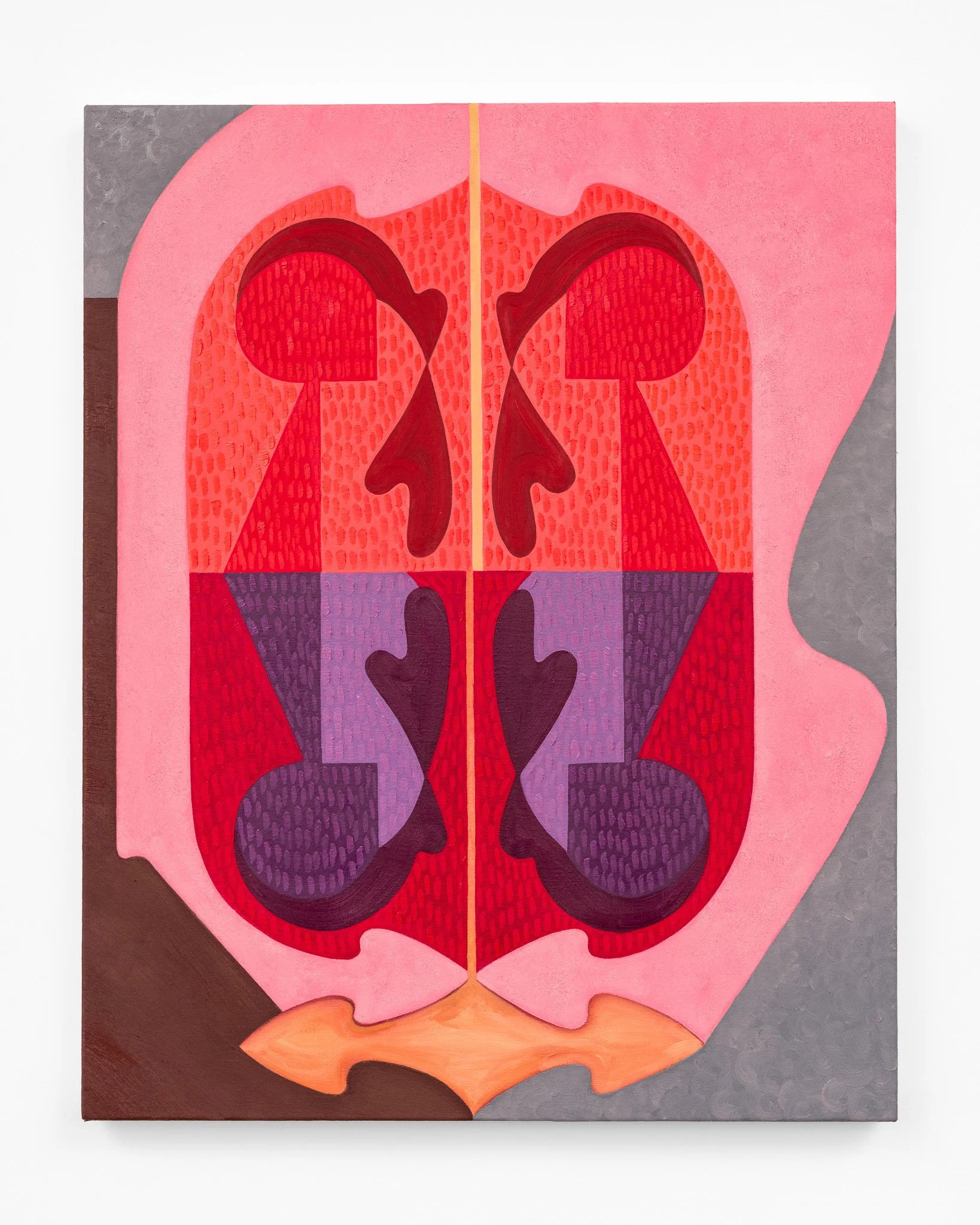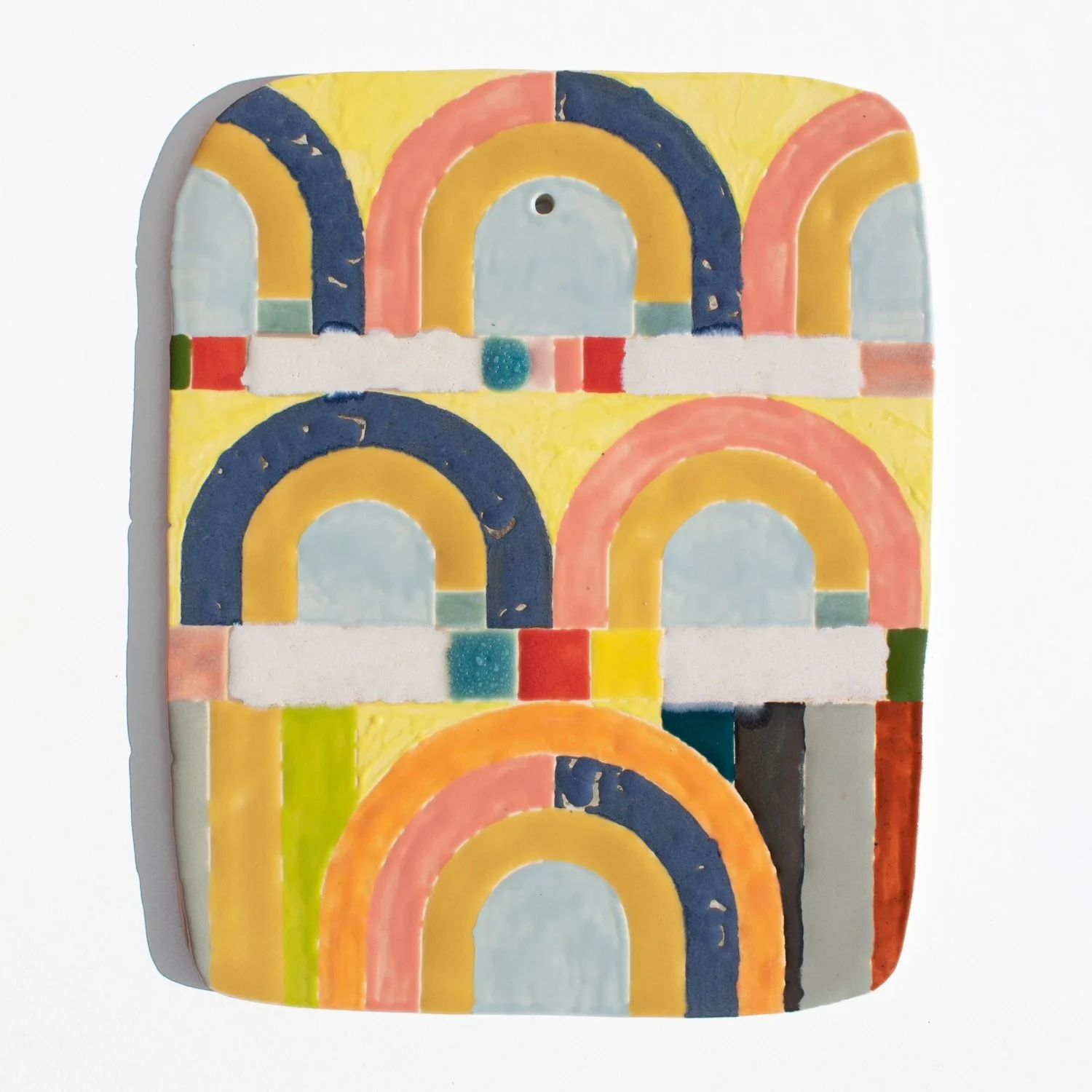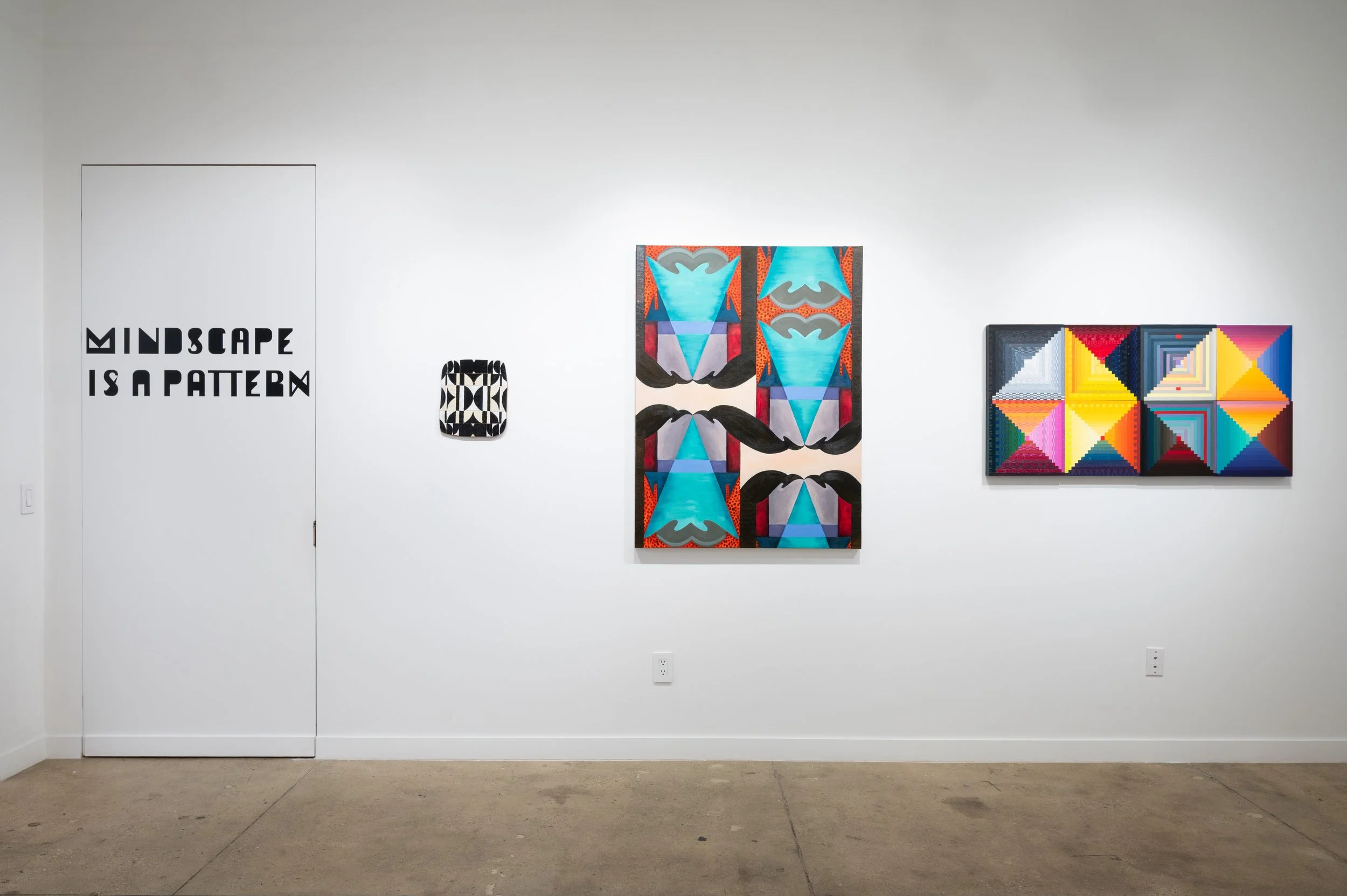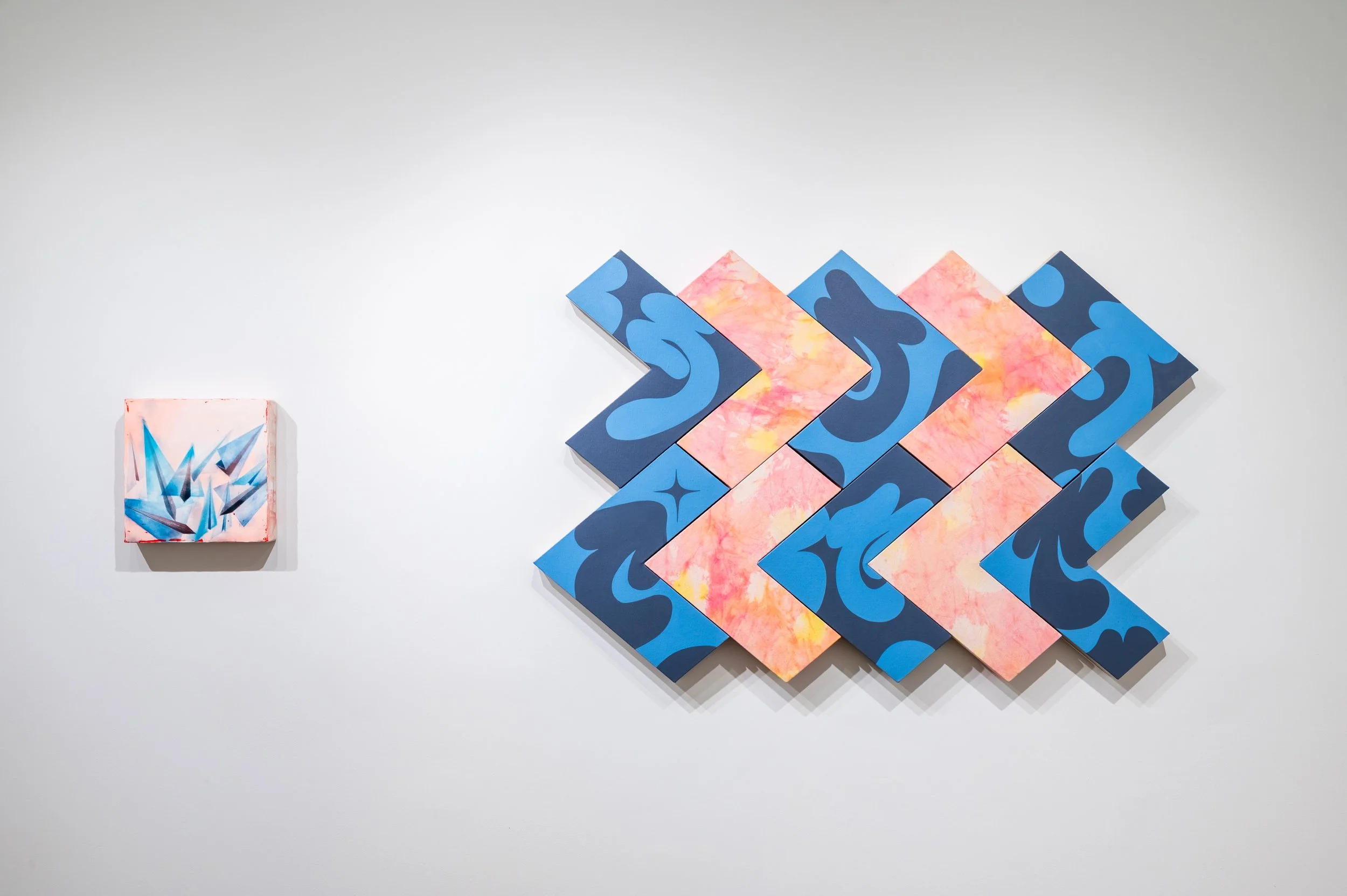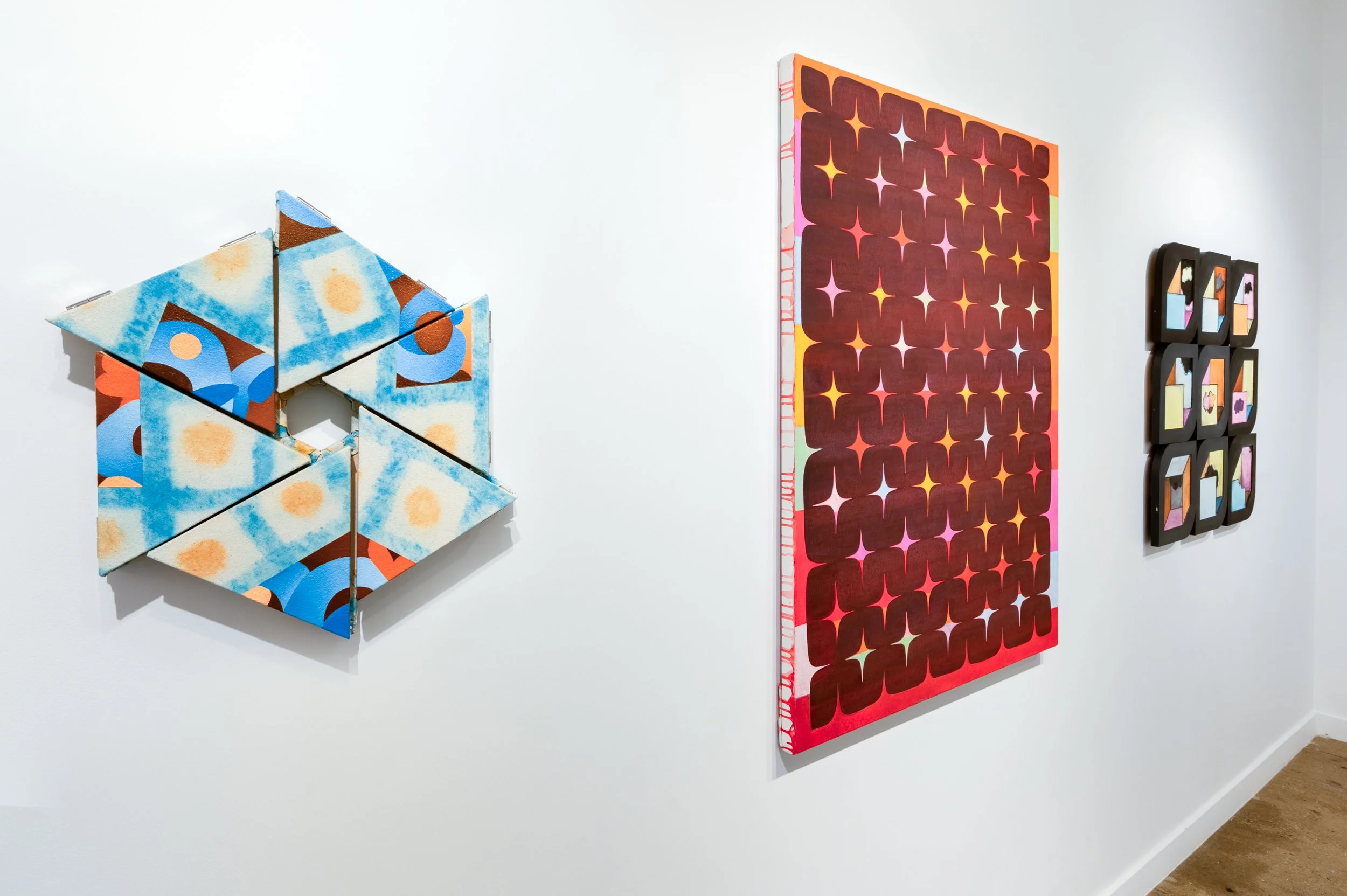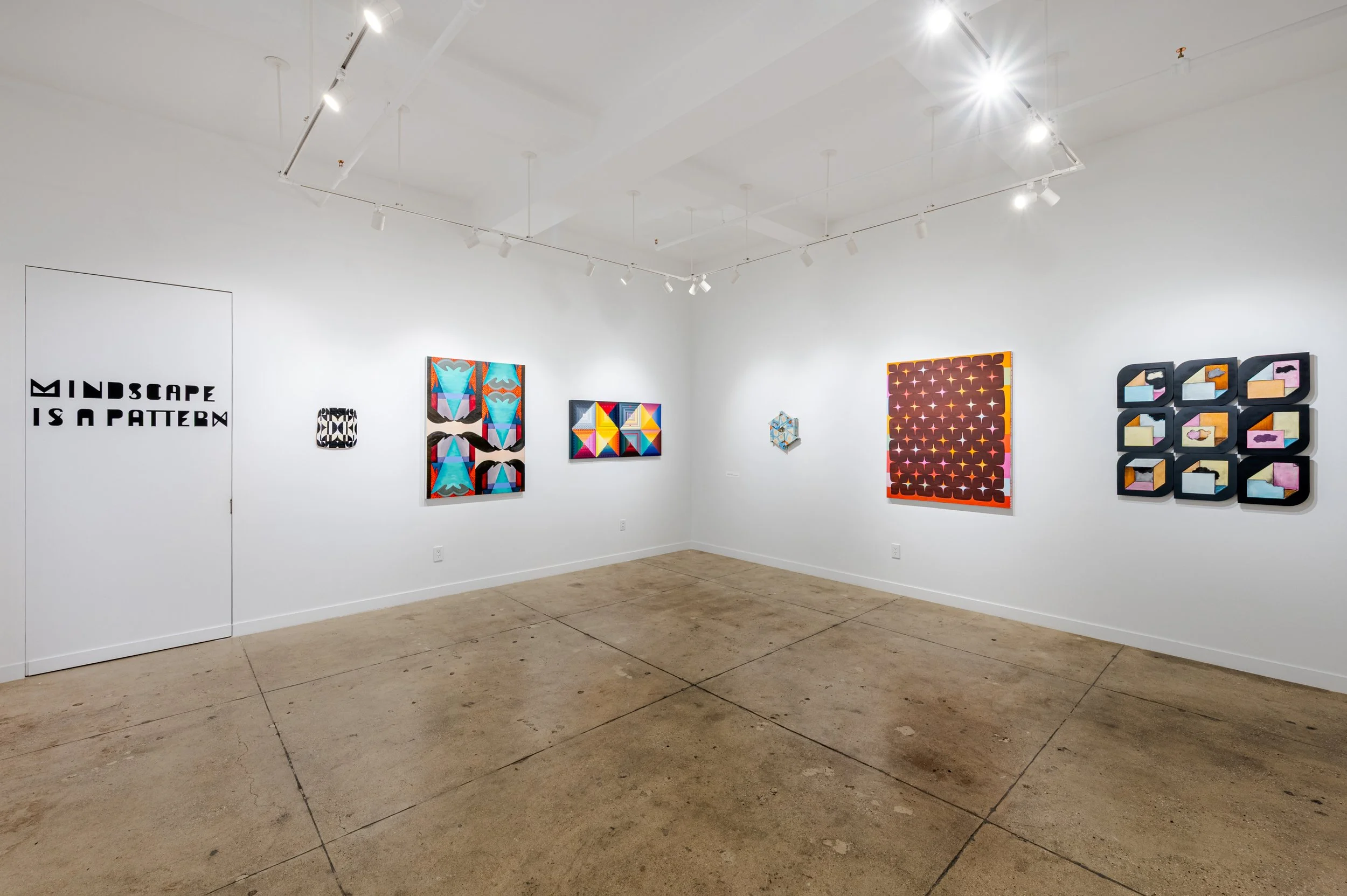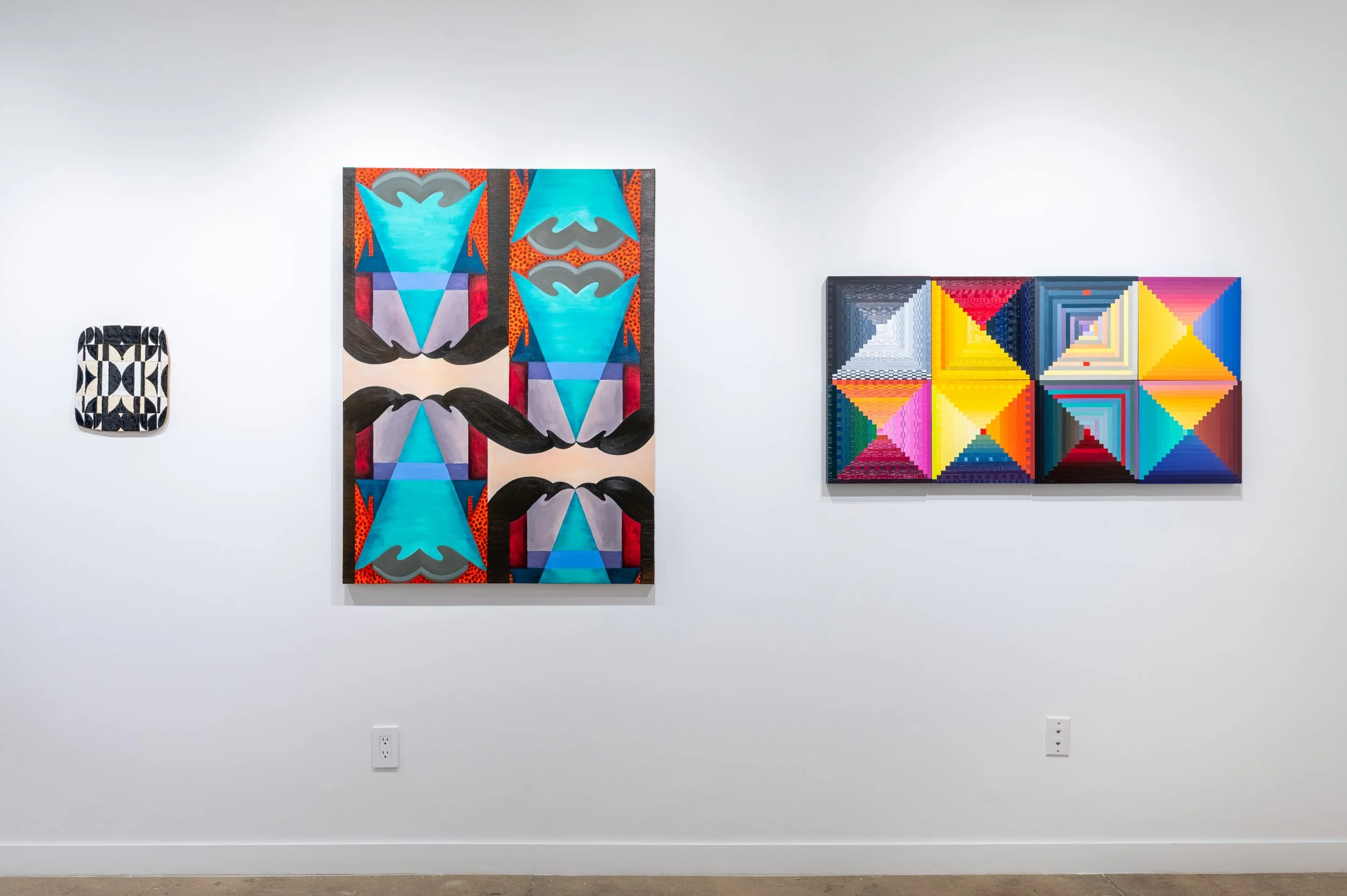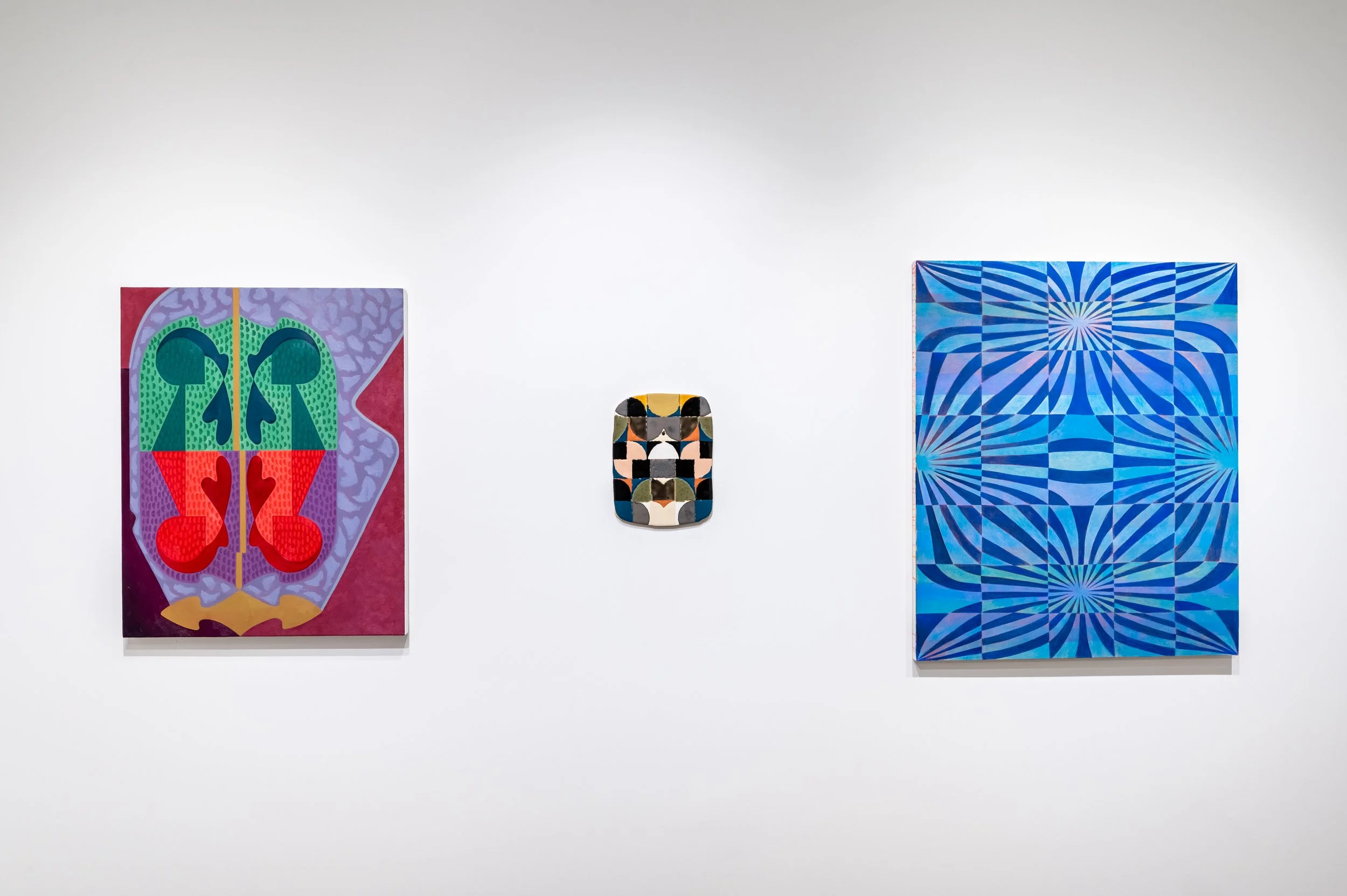Caetlynn Booth
Christopher Dunlap
Debbi Kenote
Bonnie Morano
Evan Peltzman
Kevin Umaña
************
curator
Caetlynn Booth
************
Open to the public:
Thursday, June 26 - Friday, September 19, 2025
Open hours:
Monday - Friday, 11am - 5pm
Summer Friday hours 11 am - 2pm until after Labor Day
Opening reception:
Thursday, June 26, 6-8pm
Mindscape is a Pattern is featured in the New Criterion Critic’s Pick Notebook
Mindscape is a Pattern articulates the impulse (instinct) to pattern and explores the general influence of quilt-making traditions in the contemporary painting of six artists: Caetlynn Booth, Christopher Dunlap, Debbi Kenote, Bonnie Morano, Evan Peltzman, and Kevin Umaña.
The folk-art tradition of the American quilt, composed of textiles with their own patterns and origins, has historically been categorized as a woman's art/craft form in both individual and collective contexts. Because of the ubiquitous nature of this tradition and the quantity of tremendously talented homemakers over time, quilts have touched countless lives, becoming a source for not only warmth, safety, and intimacy but also the ignition point to creativity for so many visual artists.
In putting this show together, Booth’s aim is to assemble in one space the paintings of artists whose work she has been following and with whom she shares a deep affinity in terms of how pattern is used to understand the world and to advance ideas. In the practice of these artists, one can see their minds at work, solving conceptual puzzles that not only create patterns, but set up frameworks in which pattern has a sequence, a progression, changes course, and resolves by way of wit and risk, or with a systematic approach, modular extrapolation, playfulness or humor, all tapping into the deep humanity represented in pattern-making.
As the show came together, other formal threads developed, highlighting the curatorial impulse of pulling together another type of “quilting” rhythm in matching and contrasting elements between the varied works. Anyone can enjoy and appreciate the language of pattern, yet pattern-makers will feel it aching deeply in their body, a type of knowledge only possessed by physically enacting these patterns.
Kevin Umaña, known mostly for his abstract geometric paintings, recently expanded his practice to include ceramics while investigating the history of the Pipil people, the indigenous group of El Salvador which his family derives from. Umaña’s work creates an equilibrium between the capacity as a creator and the energy of the surrounding world, and these new explorations have marked a major turning point in his life and art to uncover a hidden science within the artwork that reflects a spirituality all his own.
Debbi Kenote's work begins with handcrafted stretchers, transforming the conventional rectangular canvas into complex forms. Her designs draw from the geometry of quilts, the patterns of weaving, and the structure of Bauhaus architecture, while her palette captures shades observed in the natural world.
Bonnie Morano's work makes use of symmetry, doubling, inversion, and reflection, all revolving around the central spine of the painting to form a connection between joy and devotion, real and imagined space, and most of all, the physical and the spiritual nature of painting.
Evan Peltzman's work possesses a particular force, largely informed by his personal experience with cerebral palsy and how this has shaped his understanding of selfhood. Peltzman’s work makes use of a type of indexical language to speak to themes of frustration, confusion, adaptation, and grit, while communicating a sense of reassurance despite the obstacles.
Christopher Dunlap's work invites viewers to enter the spatial relationships established in the patterns he creates to become more conscious of how they see. He is interested in the space where perception and sensation meet, allowing meaning to emerge through the viewer’s experience.
Caetlynn Booth's work is informed by foundational experiences with quilt-making in her youth, providing a subtext to her overarching practice of exploring the spiritual qualities of intermingling observation with internal visions through time, across tonal variations, color, light, form, sequence, pattern and reflection, to distill symbolic essences that speak to feelings of interconnectedness with the worlds she inhabits.
Founded in 2011, Project: ARTspace is an interdisciplinary creative project space. Our organization programs events and exhibition where curators and artists of all levels have the chance to meet, engage and promote new collaborative projects
Artist Bios/Statements
Caetlynn Booth (b. Napa, CA) is an artist based in Queens, NY. In the spring of 2026, she will have a solo show at a gallery in Litchfield, CT. In 2019, she and Amy Lincoln had a two-person exhibition at Project: ArtSpace (New York, NY), and over the past several years, her work has been featured at Pulse Art Fair in Miami Beach and in shows at Project: ArtSpace (New York, NY); My Pet Ram (New York, NY); Tappeto Volante (Brooklyn, NY); and Tiger Strikes Asteroid (Brooklyn, NY) among others. Booth lived in Berlin, Germany, from 2011 to 2013 working on a research and painting project as a Fulbright Scholar. She has been an artist in residence at I-A-M Institut and GlogauAIR in Berlin, at the Vermont Studio Center, and at the Noxubee Wildlife Refuge in Mississippi. She received her MFA from Rutgers University (2011), and BA from the University of California at Davis (2002).
Inspired by formative experiences with quilt-making, the work in this show is part of an ongoing modular painting project, “Selvage.” Like textile-based traditions where fabric selvages and other scraps are pieced together to make a quilt, the paint for these paintings comes from left over paint initially mixed for other paintings. The project’s parameters include using the same pattern as an under-drawing, and making half of each painting lighter in value, and the other half darker so that when they are put together, an overarching pattern emerges depending on the arrangement of the individual panels. The layout is based on a design in quilt-making called “barn-raising.” This work is made in oil on 12” x 12” or 12” x 24” panels that are meant to be hung together in a variety of interchangeable arrangements, and can also stand alone. “Selvage” fits within my overarching practice of exploring the spiritual qualities of intermingling observation with internal visions through time, across tonal variations, color, light, form, sequence, pattern and reflection, to distill symbolic essences that speak to my feeling of interconnectedness with the worlds I inhabit.
Christopher Dunlap was born in Pullman, Washington. The artist received a BFA from University of Washington in Seattle, Washington and an MFA from Massachusetts College of Art and Design in Boston, Massachusetts. Solo exhibitions of Dunlap’s work have taken place at: Marvin Gardens in Ridgewood, New York; Sardine Gallery in Brooklyn, New York (2020 and 2017); and Hiromart Gallery in Tokyo, Japan (2019). Group exhibitions that have included Dunlap’s work have taken place at: New Collectors Gallery in New York City; Marvin Gardens in Ridgewood, New York; Albada Jelgersma in Amsterdam, the Netherlands; McKenzie Fine Art in New York City; Transmitter in Brooklyn, New York; No Place Gallery in Columbus, Ohio; Site 131 in Dallas, Texas; and Spring Break Art Fair in New York City. Dunlap has been reviewed in The New York Times, Two Coats of Paint, Hyperallergic, Art F City and Travel Magazine. Dunlap lives and works in Harlem, New York.
My paintings are the result of layers of intuitive decisions exploring form and pattern. I’m interested in creating a multiplicity of relationships between simple shapes and complex structures. Through specific placement, repetition, and implied perspective, the paintings assert a sense of depth while also reinforcing the support they’re painted on. Although a painting is a static object, I’m interested in creating visual relationships that unfold gradually over time through the act of looking. By making paintings that can be interpreted in multiple spatial ways, my work invites viewers to become more conscious of how they see. This kind of attention opens a space where perception and sensation meet, allowing meaning to emerge through the viewer’s experience.
Debbi Kenote (b. 1991, Anacortes, WA) has exhibited at galleries internationally, including shows at Cristin Tierney Gallery, My Pet Ram, Kate Werble, and Marvin Gardens in New York; Duran|Mashaal Gallery in Montreal; Cob Gallery in London; and Fir Gallery in Beijing. She received her BFA in Painting from Western Washington University and her MFA in Sculpture from Brooklyn College. Her work has been on display at several art fairs, including Art Toronto, Art Plural, Future Fair and SPRING/BREAK Art Show. Kenote has been published through Liquitex, Maake Magazine, Elle Magazine, Innovate Grant, Suboart, The Hopper Prize, Art of Choice, and Hyperallergic. Her work has been placed in several collections, including the OZ Art Collection and the Capital One Corporate Collection. She has been an artist in residence at the Ucross Foundation, Vermont Studio Center, Saltonstall Foundation, PLOP, Nes Artist Residency, and the Mineral School. In 2022 she was a finalist for the Innovate Grant and in 2021 she was shortlisted for the Hopper Prize. Kenote has a studio in Brooklyn, NY.
Debbi Kenote’s shaped canvases are similarly inspired by nostalgia, childhood memories, and American craft traditions. She handcrafts her stretchers, transforming the conventional rectangular canvas into complex forms. Her designs draw from the geometry of quilts, the patterns of weaving, and the structure of Bauhaus architecture, while her palette captures shades observed in the natural world. This process challenges and redefines the boundaries of painting, emphasizing the canvas’s objecthood.
Bonnie Morano is a native New Yorker, living and working in Brooklyn. She received an MFA, with a concentration in painting, from Hunter College in 2023. Her recent exhibitions include a two person show “Mysterious Bodies,” at Rhett Baruch gallery in Los Angeles in May 2025; a solo show, “Double Space,” at One River School in Allendale, NJ in March 2025 and a group show “Luxury Repeat,” at Rhett Baruch gallery in July 2024. Bonnie also holds a Master’s in Business Administration from Marist College with a focus on Ethical Leadership. Bonnie's guidance and inspiration are from her strong religious faith and her rich ethnic culture.
At the center of every human body is the trace of a life force – the powerful belly button. The idea that all growth and life stems from a central location is activated in my hard-edge abstract paintings. By using abstraction and compositional devices related to symmetry, doubling, inversion, and reflection—all revolving around the central spine of the painting—I am forming a connection between joy and devotion, real and imagined space, and most of all, the physical and the spiritual nature of painting.
Evan Peltzman is a painter who has been living and working in New York City since 2010. He is currently an MFA candidate at the School of Visual Arts in New York, graduating in 2026. Born and raised in California’s San Francisco Bay Area during the 1980’s and 90’s, Evan was heavily influenced by the artwork and aesthetic of the local skateboarding, live music and graffiti of the times. San Francisco’s DIY culture of the early 90’s inspired him to get creative with his materials, exhibition venues and studio spaces. This approach to art making continues to follow him today as he builds all of his own wood panels, canvas stretchers and frames in order to use unorthodox materials and make odd-sized work.
The force behind my work is largely driven by my lived experience of being born with cerebral palsy and the effect it had both on my childhood and adult life. I hope to connect with the viewer through the presence of obstacles in my work and the frustration, confusion, adaptation and grit that comes along with the cards that we’ve been dealt.
Kevin Umaña was born in 1989 and grew up in El Salvador and Los Angeles. He received a BFA from San Francisco State University in 2014 and lives and works in Brooklyn, NY. Umaña’s early practice focused on geometric paintings and has since expanded to include ceramics. He has completed residencies at the Josef and Annie Albers Foundation (2024); Sharpe-Walentas Studio Program (2023-24); Archie Bray Foundation for the Ceramic Arts, Helena, MT (2023); The Center for Book Arts, New York (2019); Plop Residence, London, England (2018); and SIM Residency, Reykjavik, Iceland (2018). His work was featured in “Pattern Recognition,” curated by Amy Lincoln at Sperone Wastewater in 2022. Institutions owning his work include The United Nations Art Collection, New York; The Everton Museum of Art, Syracuse, NY; The Munson Museum of Art, Utica, NY; Fidelity Mutual Funds Collection; Center for Book Arts Library, New York; and The Marin Museum of Contemporary Art, Novato, CA. Umaña is represented by Sperone Westwater in New York.
Umaña’s recent works, “hybrid paintings,” combine glazed ceramics on painted canvas and fuse together conflicting styles—mess and order, biomorphic and geometric, thin and thick, matte and sheen. These abstract representations evoke specific places from his childhood, memories of nature, beaches, plants, construction materials, food and religion. For Umaña, abstraction has been a way to explore the tranquility of nature, a search for an equilibrium between the capacity as a creator and the energy of the world around. Known mostly for his abstract geometric paintings, Umaña recently expanded his practice to include ceramics. Although color and pattern have always been an integral part of his process, the exploration of new material has recently informed more of the textural side of his work. The works, like nature, often fall into improvisation and unpredictability. The compositions and structures are carefully designed but coincide with the laws of chance, through the use of bold colors, dynamic gestures, and expressive marks. The work proposes a dialogue between the systematic and the open-ended with biomorphic and geometric elements. The result embraces chance as a tool for liberating creativity from rational thought. Ultimately setting up the conditions in which the materials and gestures become somewhat autonomous. Umaña, therefore, has no intention of creating a realistic depiction of the world but aims to capture the experience through geometric forms and create a kind of subversive connection. He has simplified, distorted, and cropped his subjects until they bear little resemblance to the original objects. Sway in a deceptive imitation of life, producing serenity of impeccable form and balance. Recently, Umaña has been investigating the history of the Pipil people, the indigenous group his family derives from. These new explorations have had a profound impact on Umaña and marked a major turning point in his life and art. He’s not only found art an essential instrument for gestural expression but a science hidden within the artwork that reflects spirituality. Umaña's current series marks a significant transition in his studio practice at several levels: formally, conceptually, culturally, and emotionally. All of the artworks are derived from painting and touch on the history of painting, the compositions are geometric and fill each support edge-to-edge. However, the series focuses on three major changes in the artist’s approach and compositions. First is Umaña’s shift from a rigorous, precise execution of his compositions to a process-driven approach influenced by his experiences and experimentation with glazes and ceramics. This has affected his painting practice most notably in terms of color and surface. The second change is a move away from non-objective geometric abstractions derived from reductions, then amplifications and patterning of architectural details (from personally meaningful location-specific buildings and bridges in various international locations) to a practice now rooted largely in picture-making. The new compositions are geometric representations of specific places. The third notable change and relating to the second is bringing into his artwork cultural references evoked from memories of his family and youth while living in El Salvador. This includes strong influences of nature, beaches, plants, construction materials, food, and religion, and thus, inherently brings a narrative that is alluded to in the descriptive titles.
Caetlynn Booth, Selvage 32, 2024, oil on panel, 12x12 in.
Christopher Dunlap, Untitled 4-8, 2025, acrylic and oil on canvas, 36x30 in.
Bonnie Morano, Bend and Stretch Coat of Arms, 2025, oil on canvas, 30x24 in.
Debbi Kenote, Hilltopping, 2022, acrylic on linen and dye on canvas, 44x31 in.
Installation photos: MichaelHnatov photography LINK TO IMAGE DETAILS
Evan Peltzman, When did the doors
really open, 2025, pastel and acrylic on canvas-wrapped wood panel, 10x10x2 in.
Kevin Umaña, Bead and Ball Maze in the Waiting Room, 2021, glaze on stoneware, 12.5x10 in.




